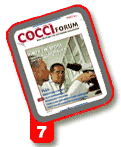Cover Story - Know the Spore
Identifying viable, sporulated oocysts key to a quality coccidiosis vaccine
 Knight: 'It's critical to have the right balance of
antigens"�'
|
Identifying viable, sporulated
Eimeria oocysts and ensuring that
birds get just the right amount is
one of the most important steps that go
into producing an effective coccidiosis
vaccine.
Even so, with thousands
of chicks moving through
the hatchery, it's difficult for
busy poultry veterinarians
and production managers
to appreciate the technology,
careful selection
process, experience and
rigid quality-control standards
that need to go into a
vaccine of this nature.
"Coccidiosis vaccination
works by providing a controlled,
carefully balanced
dose of oocysts "coccidial
eggs "to protect against
the several species of
Eimeria that cause the disease
in birds," says Graham
Knight, manager of coccidiosis
vaccine production
at Schering-Plough Animal
Health Corporation's production
plant in Millsboro, Delaware.
"It sounds easy, but there's more to
it than gathering oocysts and putting
them in a bottle. The preparation and
identification of suitable oocysts is crucial,"
he says. "It's also critical to have
the right balance of antigens, which are
the individual components that lead to
protection against the Eimeria species
causing disease."
Stimulating immunity
Producers need to understand that for a
coccidiosis vaccine to stimulate immunity,
oocysts must be capable of releasing
viable spores. "In other words, they
must be sporulated. They also must be
viable to be infective," Knight says.
"An infective oocyst is a sporulated
oocyst, but a sporulated oocyst is not
necessarily an infective one," Knight
says. "We think this is an important distinction
for producers to know and
understand."
The reason is that sporulated
oocysts age and die. In addition, some
oocysts never fully develop; they are
only partially sporulated, while others
may be abnormal or damaged and are
not infective.
"A major part of our job is the identification
of fresh, fully sporulated
oocysts," Knight says. "These are the
oocysts that are infective and that convey
immunity to birds against coccidiosis.
It takes a lot of experience to build
a quality coccidiosis vaccine."
Tried and true
Although it's a tedious and important
process, identifying viable sporulated
oocysts isn't rocket science, Knight
insists, but it does require an educated
eye.
"In Millsboro, we have well-trained,
seasoned technicians "many have
been involved since the operation was
moved to Millsboro in the 1980s. With a
good microscope, they can easily differentiate
a fresh, fully sporulated
oocyst from an oocyst that's not," he
says.
Microscopic examination is the traditional
method of determining
whether an oocyst is fully sporulated
and has been in use since the early
1900s. "It's a straightforward and
proven method, one that requires no
manipulation of the sample other than
dilution and needs no specialized
equipment or technique," Knight
explains.
Dr. Steve Fitz-Coy, now a technicalservice representative for Schering-
Plough Animal Health, agrees.
"Poultry producers have been dealing
with coccidiosis for nearly 75 years,
since groundbreaking work by E. E.
Tyzzer in 1929. Identifying sporulated
oocysts with a microscope is a tried and
true process that's improved with time,"
he says.
Knight points out that data collected
over the course of many years as well
as field experience have demonstrated
that coccidiosis vaccine made from
fresh, fully sporulated oocysts within a
fixed time frame has enough viable
oocysts of each species at the end of
the stated shelf-life (12 months) to be
efficacious.
Complementary procedures
Several other procedures built into coccidiosis-
vaccine production at Millsboro
complement the identification of viable,
sporulated oocysts and contribute to
the vaccine's efficacy, says Knight.
One is the way in which oocysts are
produced. Each coccidial species in the
vaccine is grown in birds in a room
dedicated to that species. The rooms
are located in an antigen-production
facility. The birds are not used for multiple
species nor are they re-used, he
says.
"Although most species of coccidial
oocysts can be differentiated by trained
technicians, there are exceptions.
Different species have different sizes
and shapes, but some overlap occurs,
particularly among small oocysts.
Growing each type in isolation solves
this problem," Knight says.
Technicians inoculate one group of
birds with known and tested seeds of
one coccidial species. Excreted oocysts
are then harvested and cleaned. "We
don't need to differentiate oocysts -
we only have to determine whether an
oocyst is fully sporulated or not and
how many there are.
"We need different numbers of
oocysts for each species to make
Coccivac. Ultimately, the oocysts are
blended, but we grow them individually,"
he says.
Oocyst production
Nevertheless, Fitz-Coy points out,
oocysts excreted by birds are not
sporulated when harvested and, therefore,
are not infective.
"We have to transform the harvested,
non-sporulated oocysts to the
sporulated and infective form under
controlled conditions by providing
warmth, humidity and oxygen," he
says.
Adds Knight, "We mimic nature, but
with the benefit of controlled conditions,
we can efficiently transform the
majority of oocysts over a given period
of time. Because the viability of sporulated
oocysts decreases with time, the
harvested material is processed quickly
at the Millsboro plant, which works to
cGMP (current Good Manufacturing
Practices)."
After sporulation, the antigen lot is sampled and technicians identify and
count the number of infective oocysts
per ml. "We get at least two independent
counts on freshly produced material
using light microscopy," Knight says.
The final product includes nonsporulated
and partially sporulated
oocysts, but only oocysts that are fully
sporulated are counted as infective, he
says.
Fitz-Coy says, "We must keep in
mind that oocyst viability decreases
over time. Not all originally counted
infective oocysts will be viable by the
expiration date on the vaccine."
Consequently, the Millsboro team
makes sure that every vaccine formulation
contains sufficient infective oocysts
to allow for the decay of some infective
live oocysts. "That way, the vaccine
maintains potency through its stated
shelf-life," he says.
Antigen production is complete
once the harvest has been treated with
a chemical sterilant and quality control
has released the lot on sterility, purity
and titer, he says.
Potency testing
To be absolutely certain every final vaccine
serial (a blend of individual vaccine
lots) is efficacious, technicians
conduct potency testing in live birds,
says Knight. "Vaccinated birds are challenged
with each Eimeria line to make
sure immunity has developed.
Unvaccinated control birds also are
challenged to ensure the validity of the
test."
Besides making sure that every
batch of vaccine contains enough
viable, sporulated oocysts, the count
also ensures that birds aren't exposed
to too many, which could cause a
stronger than needed immune
response.
"Actually, the formulation ensures
that fresh vaccine is not too potent,"
says Knight, "but as an extra precaution,
we conduct safety tests in birds at
an increased dose level.
"The nature of the potency test
makes it both time- and resource-consuming.
It also eats into the available
expiration dating of the product.
However, we still believe that a challenge
potency test is the best way to
demonstrate vaccine efficacy," he says.
Additional testing
Every batch of Coccivac also is tested
for the presence of extraneous viable bacteria and fungi, according to USDA
regulations and, for added measure, for
mycoplasma even though this testing is
not a government requirement.
"Although the potency test is critical
because it demonstrates that all species
are present in sufficient numbers to initiate
the immunizing process, that
alone is not enough to warrant release
of the vaccine," he says. Further testing
is carried out to demonstrate freedom
from contaminating viral agents.
The effectiveness of Coccivac is
ensured by a range of measures starting
with the quality of raw materials and
ending with shipment of the product,
according to Knight.
"Every single stage of production,
be it a quality-control test, an inprocess
check, an incubation temperature
or storage time, is documented
and reviewed for compliance prior to
Source: CocciForum Issue No.7, Schering-Plough Animal Health.







